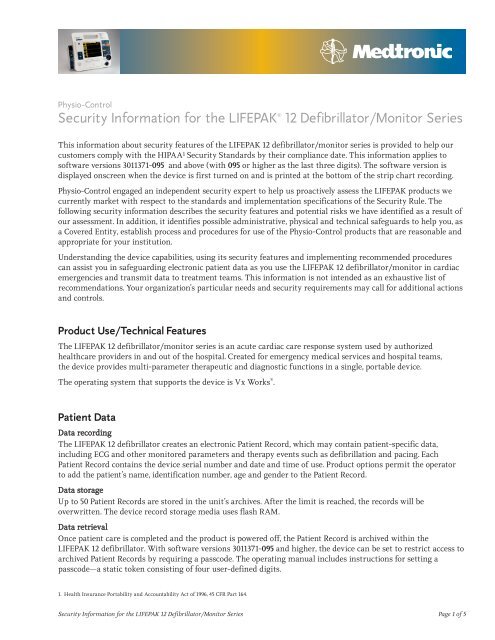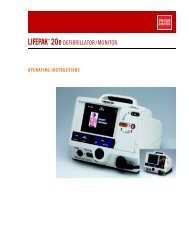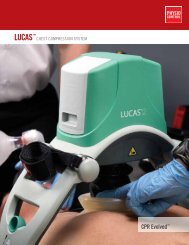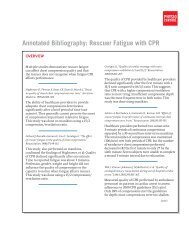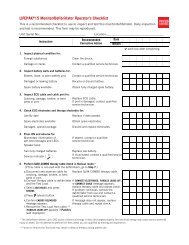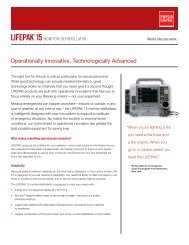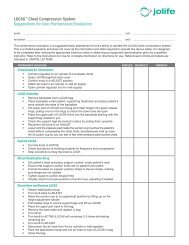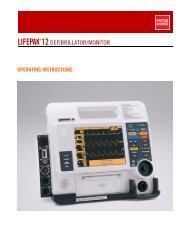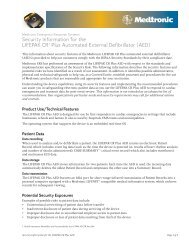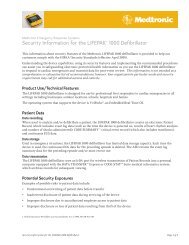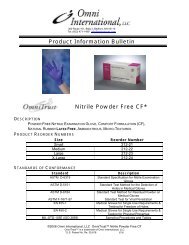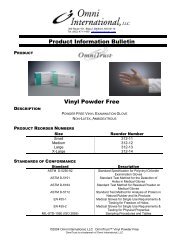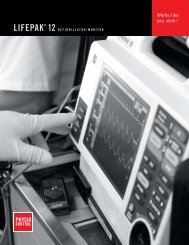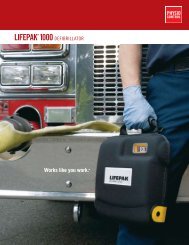Security Information for the LIFEPAK® 12 ... - Physio Control
Security Information for the LIFEPAK® 12 ... - Physio Control
Security Information for the LIFEPAK® 12 ... - Physio Control
You also want an ePaper? Increase the reach of your titles
YUMPU automatically turns print PDFs into web optimized ePapers that Google loves.
<strong>Physio</strong>-<strong>Control</strong><br />
<strong>Security</strong> <strong>In<strong>for</strong>mation</strong> <strong>for</strong> <strong>the</strong> LIFEPAK ® <strong>12</strong> Defibrillator/Monitor Series<br />
This in<strong>for</strong>mation about security features of <strong>the</strong> LIFEPAK <strong>12</strong> defibrillator/monitor series is provided to help our<br />
customers comply with <strong>the</strong> HIPAA 1 <strong>Security</strong> Standards by <strong>the</strong>ir compliance date. This in<strong>for</strong>mation applies to<br />
software versions 3011371-095 and above (with 095 or higher as <strong>the</strong> last three digits). The software version is<br />
displayed onscreen when <strong>the</strong> device is first turned on and is printed at <strong>the</strong> bottom of <strong>the</strong> strip chart recording.<br />
<strong>Physio</strong>-<strong>Control</strong> engaged an independent security expert to help us proactively assess <strong>the</strong> LIFEPAK products we<br />
currently market with respect to <strong>the</strong> standards and implementation specifications of <strong>the</strong> <strong>Security</strong> Rule. The<br />
following security in<strong>for</strong>mation describes <strong>the</strong> security features and potential risks we have identified as a result of<br />
our assessment. In addition, it identifies possible administrative, physical and technical safeguards to help you, as<br />
a Covered Entity, establish process and procedures <strong>for</strong> use of <strong>the</strong> <strong>Physio</strong>-<strong>Control</strong> products that are reasonable and<br />
appropriate <strong>for</strong> your institution.<br />
Understanding <strong>the</strong> device capabilities, using its security features and implementing recommended procedures<br />
can assist you in safeguarding electronic patient data as you use <strong>the</strong> LIFEPAK <strong>12</strong> defibrillator/monitor in cardiac<br />
emergencies and transmit data to treatment teams. This in<strong>for</strong>mation is not intended as an exhaustive list of<br />
recommendations. Your organization’s particular needs and security requirements may call <strong>for</strong> additional actions<br />
and controls.<br />
Product Use/Technical Features<br />
The LIFEPAK <strong>12</strong> defibrillator/monitor series is an acute cardiac care response system used by authorized<br />
healthcare providers in and out of <strong>the</strong> hospital. Created <strong>for</strong> emergency medical services and hospital teams,<br />
<strong>the</strong> device provides multi-parameter <strong>the</strong>rapeutic and diagnostic functions in a single, portable device.<br />
The operating system that supports <strong>the</strong> device is Vx Works ® .<br />
Patient Data<br />
Data recording<br />
The LIFEPAK <strong>12</strong> defibrillator creates an electronic Patient Record, which may contain patient-specific data,<br />
including ECG and o<strong>the</strong>r monitored parameters and <strong>the</strong>rapy events such as defibrillation and pacing. Each<br />
Patient Record contains <strong>the</strong> device serial number and date and time of use. Product options permit <strong>the</strong> operator<br />
to add <strong>the</strong> patient’s name, identification number, age and gender to <strong>the</strong> Patient Record.<br />
Data storage<br />
Up to 50 Patient Records are stored in <strong>the</strong> unit’s archives. After <strong>the</strong> limit is reached, <strong>the</strong> records will be<br />
overwritten. The device record storage media uses flash RAM.<br />
Data retrieval<br />
Once patient care is completed and <strong>the</strong> product is powered off, <strong>the</strong> Patient Record is archived within <strong>the</strong><br />
LIFEPAK <strong>12</strong> defibrillator. With software versions 3011371-095 and higher, <strong>the</strong> device can be set to restrict access to<br />
archived Patient Records by requiring a passcode. The operating manual includes instructions <strong>for</strong> setting a<br />
passcode—a static token consisting of four user-defined digits.<br />
1. Health Insurance Portability and Accountability Act of 1996, 45 CFR Part 164.<br />
<strong>Security</strong> <strong>In<strong>for</strong>mation</strong> <strong>for</strong> <strong>the</strong> LIFEPAK <strong>12</strong> Defibrillator/Monitor Series<br />
Page 1 of 5
Data transmission<br />
For patient care or data archiving purposes, data may be transferred from <strong>the</strong> LIFEPAK <strong>12</strong> defibrillator to a<br />
computer running <strong>Physio</strong>-<strong>Control</strong> medical in<strong>for</strong>matics software, such as <strong>the</strong> LIFENET ® RS receiving station,<br />
LIFENET EMS or CODE-STAT Suite. Patient Records can be transmitted from <strong>the</strong> LIFEPAK <strong>12</strong> defibrillator using<br />
cellular phone modems, analog phone modems, wireless connections or serial connections.<br />
The LIFENET BLUE product option uses Bluetooth ® encryption technology, which helps protect electronic patient<br />
data during wireless transmission from <strong>the</strong> LIFEPAK <strong>12</strong> defibrillator to a cell phone or directly to a computer<br />
running medical in<strong>for</strong>matics software.<br />
Potential <strong>Security</strong> Exposures<br />
Examples of possible risks to electronic patient data include:<br />
• Accidental deletion be<strong>for</strong>e Patient Records are backed up<br />
• Unintentional disclosure during servicing of <strong>the</strong> device<br />
• Improper disclosure due to unauthorized employee access to archived Patient Records<br />
• Improper disclosure or loss of Patient Records resulting from <strong>the</strong>ft of <strong>the</strong> device<br />
LIFEPAK <strong>12</strong> Defibrillator <strong>Security</strong> Features<br />
These security features and recommended procedures <strong>for</strong> proper use of <strong>the</strong> defibrillator/monitor are intended to<br />
facilitate your HIPAA security compliance ef<strong>for</strong>ts.<br />
Administrative Safeguards<br />
HIPAA Standard <strong>Security</strong> Issue and Feature Recommended Action<br />
<strong>In<strong>for</strong>mation</strong> Access<br />
Management (to implement<br />
policies and procedures<br />
authorizing access to<br />
electronic patient data)<br />
For each device use, <strong>the</strong> defibrillator<br />
maintains a Patient Record that<br />
includes <strong>the</strong> device serial number<br />
and date and time<br />
of use. The healthcare provider<br />
has <strong>the</strong> option of adding patient<br />
name, age, gender and identification<br />
number.<br />
To help prevent improper disclosure or<br />
loss of electronic patient data,<br />
implement procedures to delete <strong>the</strong><br />
Patient Record from <strong>the</strong> device after<br />
each use and when <strong>the</strong> Patient Record<br />
has been downloaded to backup storage.<br />
To help prevent improper disclosure of<br />
electronic patient data, have servicing<br />
per<strong>for</strong>med only by personnel trained in<br />
handling protected health in<strong>for</strong>mation.<br />
Contingency Plan (to<br />
respond to an occurrence<br />
that damages systems<br />
containing electronic<br />
patient data)<br />
Medtronic’s CODE-STAT Suite<br />
medical in<strong>for</strong>matics system can be<br />
used to support backup and recovery<br />
of Patient Records stored temporarily<br />
in <strong>the</strong> <strong>12</strong>’s archives.<br />
If long-term retention of Patient Records<br />
is desired, transfer those records to <strong>the</strong><br />
CODE-STAT Suite application be<strong>for</strong>e<br />
deleting <strong>the</strong>m from <strong>the</strong> device.<br />
<strong>Security</strong> <strong>In<strong>for</strong>mation</strong> <strong>for</strong> <strong>the</strong> LIFEPAK <strong>12</strong> Defibrillator/Monitor Series<br />
Page 2 of 5
Physical Safeguards<br />
HIPAA Standard <strong>Security</strong> Issue and Feature Recommended Action<br />
Device and Media <strong>Control</strong>s<br />
(to govern receipt,<br />
movement and removal of<br />
hardware and electronic<br />
media)<br />
To support <strong>the</strong> timely delivery of<br />
patient care in critical and emergency<br />
situations, <strong>the</strong> device is designed to<br />
grant caregivers immediate access to<br />
<strong>the</strong> product’s patient care features.<br />
The device should be kept out of <strong>the</strong><br />
hands of unauthorized users to reduce<br />
<strong>the</strong> chance of <strong>the</strong>m gaining access to<br />
archived Patient Records. Policies and<br />
procedures must balance <strong>the</strong> need to<br />
protect <strong>the</strong> device from unauthorized<br />
physical access while keeping it<br />
readily available to operators.<br />
To increase protection of Patient<br />
Records, implement procedures to<br />
physically secure <strong>the</strong> device from <strong>the</strong><br />
time of service until electronic patient<br />
data is deleted from <strong>the</strong> device.<br />
Technical Safeguards<br />
HIPAA Standard <strong>Security</strong> Issue and Feature Recommended Action<br />
Access <strong>Control</strong>s (to allow<br />
access only to those granted<br />
access rights)<br />
To provide <strong>for</strong> rapid response to<br />
cardiac emergencies, <strong>the</strong> device does<br />
not require users to log-on in order to<br />
use it.<br />
Once patient care is completed and<br />
<strong>the</strong> product is powered off, <strong>the</strong> Patient<br />
Record is archived within <strong>the</strong> device.<br />
To balance <strong>the</strong> need <strong>for</strong> ready access<br />
to archived data with <strong>the</strong> need to<br />
prevent access by unauthorized users,<br />
<strong>the</strong> device provides <strong>the</strong> ability to set a<br />
passcode—a static token consisting of<br />
4 digits, which is not user-unique.<br />
In all software versions, <strong>the</strong> device<br />
can be set to require a four-digit<br />
passcode be<strong>for</strong>e set-up options can be<br />
changed (such as which phone<br />
numbers <strong>the</strong> device dials when<br />
transmitting data).<br />
With software versions 3011371-095<br />
and higher, <strong>the</strong> device may be set to<br />
require a four-digit passcode in order<br />
to view <strong>the</strong> archive and/or to delete<br />
Patient Records.<br />
Prior to placing <strong>the</strong> device into service,<br />
change <strong>the</strong> default set-up passcode.<br />
With software versions 3011371-095 and<br />
higher, use <strong>the</strong> option to set a passcode<br />
to prevent unauthorized users from<br />
accessing or deleting archived data.<br />
Turn off <strong>the</strong> device after each use, as<br />
this archives <strong>the</strong> Patient Record.<br />
Periodically ensure that device<br />
access is restricted to authorized<br />
individuals.<br />
Implement procedures to physically<br />
secure <strong>the</strong> device from <strong>the</strong> time of<br />
service until electronic patient data is<br />
deleted from <strong>the</strong> device.<br />
Customers with software versions below<br />
3011371-095 may wish to contact your<br />
service rep to arrange <strong>for</strong> purchase and<br />
installation of <strong>the</strong> higher security<br />
software version.<br />
<strong>Security</strong> <strong>In<strong>for</strong>mation</strong> <strong>for</strong> <strong>the</strong> LIFEPAK <strong>12</strong> Defibrillator/Monitor Series<br />
Page 3 of 5
Technical Safeguards (continued)<br />
Setting <strong>the</strong> optional security<br />
passcodes increases data protection,<br />
but does not absolutely prevent<br />
someone who has physical access to<br />
<strong>the</strong> device from ultimately<br />
ascertaining <strong>the</strong> access code<br />
(through, <strong>for</strong> example, a trial and<br />
error approach.<br />
The product’s proprietary data<br />
management and store location<br />
strategy make data difficult to read<br />
without specialized software.<br />
Integrity (to protect<br />
electronic patient data from<br />
improper alteration or<br />
destruction)<br />
Transmission <strong>Security</strong> (to<br />
protect electronic patient<br />
data transmitted over an<br />
electronic communications<br />
network)<br />
The device maintains a Patient<br />
Record <strong>for</strong> each device use and can<br />
store up to 50 records. After <strong>the</strong> limit<br />
is reached, <strong>the</strong> records will be<br />
written over.<br />
To facilitate patient care or to archive<br />
data, <strong>the</strong> device can transfer Patient<br />
Records via cellular phone modems,<br />
analog phone modems, wireless<br />
connections or serial connections.<br />
The LIFENET BLUE product option<br />
uses Bluetooth technology to encrypt<br />
data during wireless transmission<br />
from <strong>the</strong> LIFEPAK <strong>12</strong> defibrillator.<br />
This protects Patient Records as <strong>the</strong>y<br />
are transmitted to a cell phone or<br />
directly to a computer running<br />
medical in<strong>for</strong>matics software.<br />
Typically, however, data from <strong>the</strong><br />
defibrillator is first sent to a cell<br />
phone and <strong>the</strong>n transmitted to a<br />
computer. No encryption of Patient<br />
Records is provided during<br />
transmission from <strong>the</strong> cell phone to<br />
<strong>the</strong> analog modem on <strong>the</strong> computer<br />
that receives <strong>the</strong> data.<br />
To reduce risk of data loss, implement<br />
procedures to download <strong>the</strong> Patient<br />
Record after each use or at <strong>the</strong> end of<br />
each day.<br />
When data is sent from a cell phone<br />
to a computer running medical<br />
in<strong>for</strong>matics software, implement<br />
policies and mechanisms as appropriate<br />
to secure data transmission. Customers<br />
who regularly transmit electronic<br />
patient data may contact <strong>Physio</strong>-<strong>Control</strong><br />
at 1.800.442.1142 <strong>for</strong> more in<strong>for</strong>mation<br />
on transmission security.<br />
<strong>Security</strong> <strong>In<strong>for</strong>mation</strong> <strong>for</strong> <strong>the</strong> LIFEPAK <strong>12</strong> Defibrillator/Monitor Series<br />
Page 4 of 5
IMPORTANT NOTE<br />
This document provides a description of certain security features of <strong>the</strong> LIFEPAK <strong>12</strong> defibrillator/monitor series.<br />
In addition, it provides recommended actions and suggested controls that may help you mitigate or o<strong>the</strong>rwise<br />
address <strong>the</strong> in<strong>for</strong>mation security risks that are associated with <strong>the</strong> product’s use. However, <strong>the</strong>se security features,<br />
recommended actions, and suggested controls may not ensure that all security incidents can be avoided, such as<br />
those related to <strong>the</strong> inadvertent or <strong>the</strong> unauthorized disclosure, deletion, or modification of a patient’s health<br />
in<strong>for</strong>mation. In addition, this document is not intended to provide, and should not be relied upon as, a<br />
comprehensive description or an exhaustive list of recommended actions and controls. As a result, depending<br />
upon <strong>the</strong> particular security requirements and needs of your organization, additional actions and controls may<br />
need to be implemented by your organization.<br />
<strong>Security</strong> <strong>In<strong>for</strong>mation</strong> <strong>for</strong> <strong>the</strong> LIFEPAK <strong>12</strong> Defibrillator/Monitor Series<br />
Page 5 of 5<br />
<strong>Physio</strong>-<strong>Control</strong> • 11811 Willows Road NE • PO Box 97006 • Redmond, WA 98073-9706 • 800.442.1142 • www.physio-control.com<br />
LIFEPAK and LIFENET are registered trademarks of Medtronic, Inc. CODE-STAT is a trademark of Medtronic, Inc. Bluetooth is a registered trademark of Bluetooth SIG, Inc.<br />
Vx Works is a registered trademark of Wind River Systems, Inc.<br />
©2007 <strong>Physio</strong>-<strong>Control</strong>, Inc., a division of Medtronic. MIN 3205413-001 / CAT 26500-001913


